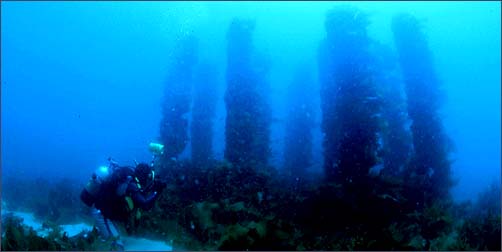
|
Vol. 23 Oki Islands. Experimental seaweed recovery farm. |

|
Vol. 23 Oki Islands. Experimental seaweed recovery farm. |

|
|
Today, many parts of Japan face the problem of 'isoyake'. 'Isoyake' is
a serious condition of the seabottom. When places where large seaweeds were growing and suddenly disappear, small calcium seaweeds take over and cover the seabottom. After a while, the entire seabottom turns into a burnt out ruin. Originally, the space on the seabottom created by the large seaweeds were an ideal place for small fish and fries. Bentic animals such as ear shells, turban shells, and sea urchins grow by eating the young buds of these large seaweeds. Though the cause is as yet unclear, something is going wrong with the seaweed that sustains the base of the sea's environment. Many theories abound from warming of the sea water, entropy of the sea water due to domestic waste water from the city, to cutting off of the ecosystems between the land and ocean by dams etc. Let me try to explain simply why "the seaweed is such an important part of the Earth's environment". Only plant life can undergo photosynthesis by using the "sun's rays", the energy received from the sun, and the inorganic substances contained in the Earth (environment) like phospor and calcium. Animals live by eating the energy produced by plants (herbivores), or live by eating animals that eat plants (carnivores) Let's take the human being (a polyhagous animal) as an example and ponder upon it. We live by eating grain such as wheat and rice, and the meats from pigs and cows. In other words, we eat the metabolized energy produced by photosynthesis of plants (wheat and rice) or eat the animals that eat these plants (pigs and cows) in order to live. As the central axis of the food cycle on land is the plant life, it is no wonder that the central axis of the food cycle in the ocean, which covers the remaining two thirds of the Earth, is a plant as well. I guess I have made a rather lengthy introduction. As we come to realize the importance of the seeweed, we try in haste, various methods of recovering it. Life is not so simple however. Although the seaweed grew luxuriantly like weeds and was treated as a nuisance, to bring them back by our hand is very difficult. It is only natural that seaweed will not grow in an environment where they can no longer live. The change in water temperature, marine creatures who live on seaweed and vie with each other to eat the cultivated weed, the struggle with other creatures for existance in the same habitat etc., are all part of the may difficult realities we face. When I heard of a seaweed farm on an experimental reef off Oki Islands, in the Sea of Japan, which is making good progress, I decided to visit. The experimental reef behind the island is as follows. In the many concrete bases that are shaped like a cross, stand four-meter poles like telephone poles. 'Tsuruarame' seaweed, which is a specialty of the Sea of Japan, is fixed with plastic fixtures to the concrete poles. These poles create a favorable environment for the seaweed's growth in terms of tide movements and exposure to sunlight. The 'tsuruarame' seaweed is perennial seaweed that is resilient to changes in the environment. It has a unique way of mulitplying by spreading its roots over the rocks and sprouting new buds from there. The Oki Islands are located in the center of the Sea of Japan and are an ideal environment for the seaweed's growth. The islands could not remain free of the 'isoyake' damage however, and sustained some harm. In the past, we humans neglected damage to the environment. I hope this experimental reef for the recovery of seaweed continues to grow the 'tsuruarame' seaweed for a long time and remains a key spot to research the ways that man can understand the seaweed more deeply and coexist with them. Man has received unlimited gifts from the sea since the earliest of times. Now, with the approach of the millenium if we can feel the shadow falling upon this equation, perhaps this 'isoyake' is a warning to us from the sea.
|
|
|